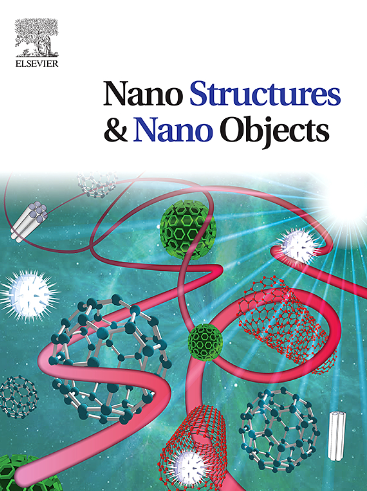掺cao纳米ZrO2晶体的热致结构行为:高温同步加速器XRD和XAS研究
IF 5.45
Q1 Physics and Astronomy
引用次数: 0
摘要
采用高温同步加速器x射线粉末衍射(XRD)和x射线吸收光谱(XAS)研究了未掺杂和掺cao纳米晶ZrO2的晶体结构和局部结构。采用共沉淀法合成纳米晶ZrO2,以天然石灰石中提取的CaO为掺杂剂,采用机械化学湿磨法制备掺杂CaO的ZrO2。高温同步加速器XRD分析表明,未掺杂和掺cao的ZrO2由非晶态转变为方形相,在1100℃下稳定。与未掺杂的样品相比,cao掺杂的ZrO2需要更高的温度才能实现完全的四方转变。在同等温度下,Ca掺杂导致晶格参数增大,四方性降低,单元胞体积收缩速度减慢。当CaO掺杂浓度为5.0 mol%的ZrO2以50 °C/min的速度快速冷却后,可诱导形成少量相,特别是m-ZrO2和CaZrO3。此外,在700°C和800°C的原位扩展x射线吸收精细结构(EXAFS)分析表明,Ca掺杂剂通过用更大的Ca2+离子取代Zr4+并形成氧空位来拉长Zr-OI键,有效地抑制了原子振动。本文的研究结果指出了cao掺杂ZrO2纳米晶体的结构适应性,增强了其在高温应用中的适用性。本文章由计算机程序翻译,如有差异,请以英文原文为准。
Thermal-induced structural behavior in CaO-doped ZrO2 nanocrystals: A high-temperature synchrotron XRD and XAS study
The crystal and local structures of nanocrystalline undoped and CaO-doped ZrO2 were investigated using high-temperature synchrotron X-ray powder diffraction (XRD) and X-ray absorption spectroscopy (XAS). Nanocrystalline ZrO2 was synthesized via a co-precipitation method, whereas CaO-doped ZrO2 was prepared through mechanochemical wet milling, using CaO derived from natural limestone as the dopant. High-temperature synchrotron XRD analysis showed the transformation of undoped and CaO-doped ZrO2 from an amorphous state to a tetragonal phase, stable up to 1100 °C. The CaO-doped ZrO2 required higher temperatures to achieve a fully tetragonal transformation compared to the undoped sample. At equivalent temperatures, Ca doping induced larger lattice parameters, reduced tetragonality, and slower unit-cell volume contraction. However, CaO-doped ZrO2 with 5.0 mol% CaO dopant concentration following fast cooling at a rate of 50 °C/min induced the formation of minor phases, specifically m-ZrO2 and CaZrO3. Furthermore, in situ extended X-ray absorption fine structure (EXAFS) analysis at 700 and 800 °C revealed that the Ca dopant elongated Zr-OI bonds by substituting Zr4+ with larger Ca2+ ions and forming oxygen vacancies, effectively suppressing atomic vibrations. The results reported here point out the structural adaptability of CaO-doped ZrO2 nanocrystals, reinforcing their suitability for high-temperature applications.
求助全文
通过发布文献求助,成功后即可免费获取论文全文。
去求助
来源期刊

Nano-Structures & Nano-Objects
Physics and Astronomy-Condensed Matter Physics
CiteScore
9.20
自引率
0.00%
发文量
60
审稿时长
22 days
期刊介绍:
Nano-Structures & Nano-Objects is a new journal devoted to all aspects of the synthesis and the properties of this new flourishing domain. The journal is devoted to novel architectures at the nano-level with an emphasis on new synthesis and characterization methods. The journal is focused on the objects rather than on their applications. However, the research for new applications of original nano-structures & nano-objects in various fields such as nano-electronics, energy conversion, catalysis, drug delivery and nano-medicine is also welcome. The scope of Nano-Structures & Nano-Objects involves: -Metal and alloy nanoparticles with complex nanostructures such as shape control, core-shell and dumbells -Oxide nanoparticles and nanostructures, with complex oxide/metal, oxide/surface and oxide /organic interfaces -Inorganic semi-conducting nanoparticles (quantum dots) with an emphasis on new phases, structures, shapes and complexity -Nanostructures involving molecular inorganic species such as nanoparticles of coordination compounds, molecular magnets, spin transition nanoparticles etc. or organic nano-objects, in particular for molecular electronics -Nanostructured materials such as nano-MOFs and nano-zeolites -Hetero-junctions between molecules and nano-objects, between different nano-objects & nanostructures or between nano-objects & nanostructures and surfaces -Methods of characterization specific of the nano size or adapted for the nano size such as X-ray and neutron scattering, light scattering, NMR, Raman, Plasmonics, near field microscopies, various TEM and SEM techniques, magnetic studies, etc .
 求助内容:
求助内容: 应助结果提醒方式:
应助结果提醒方式:


